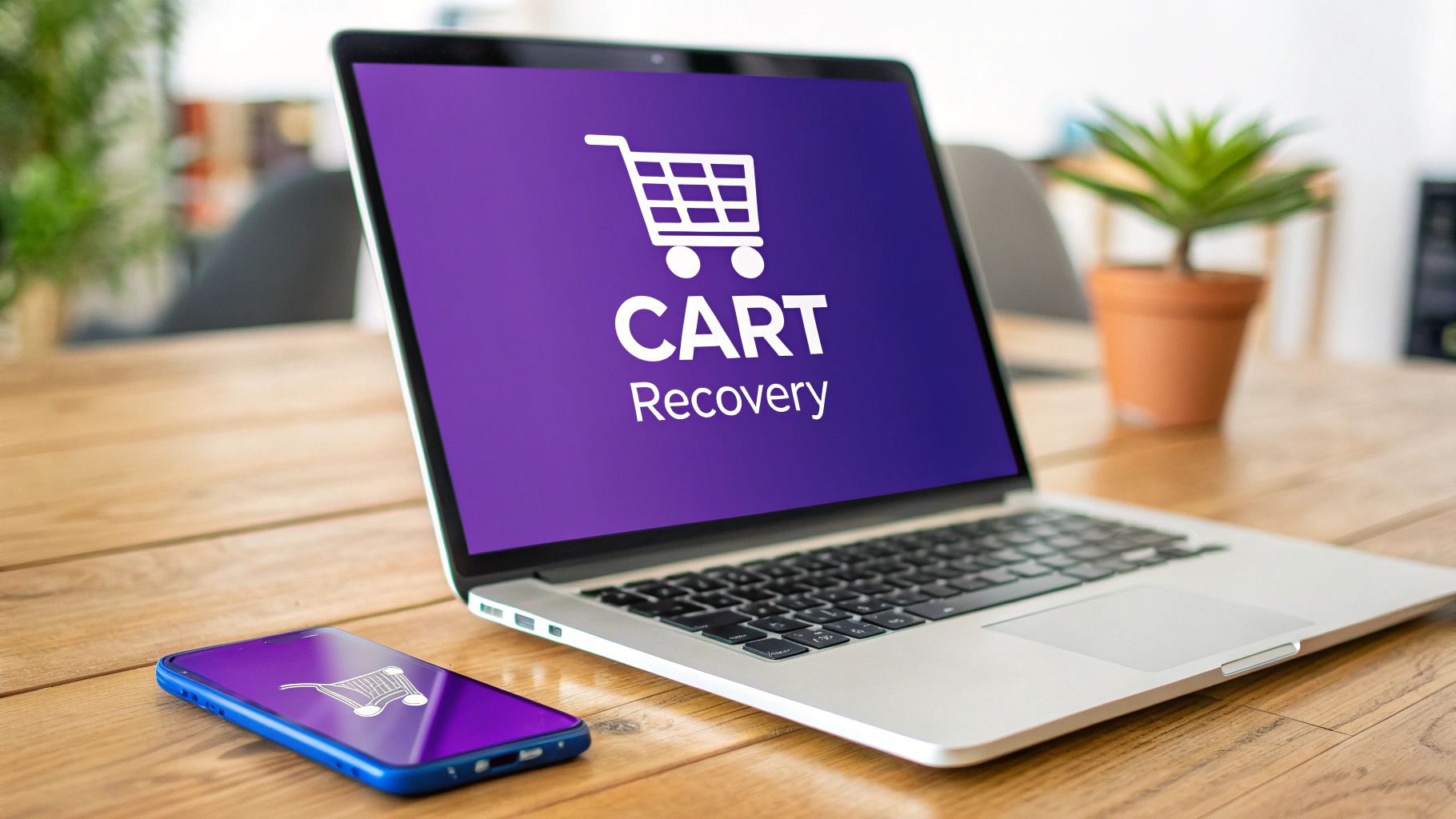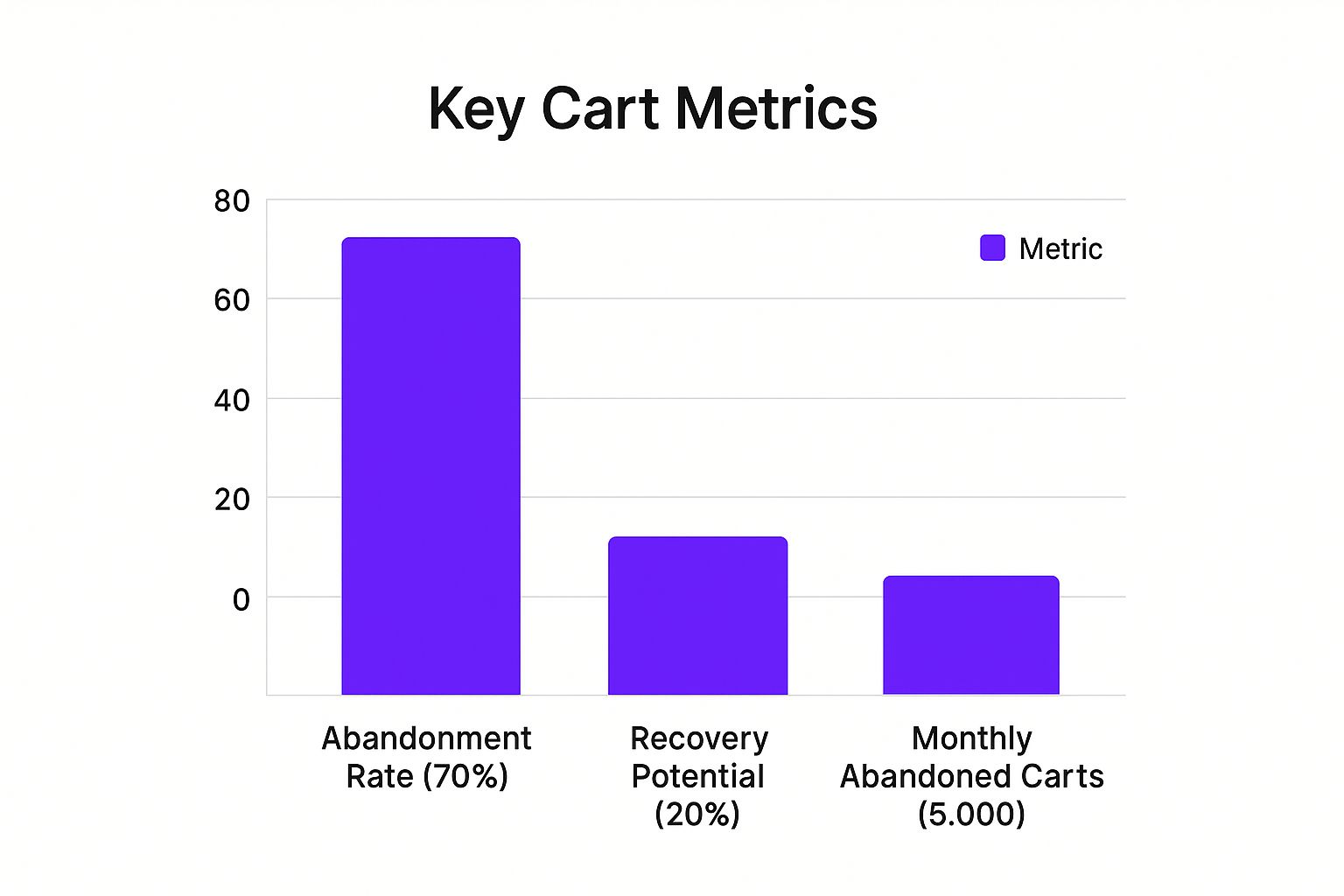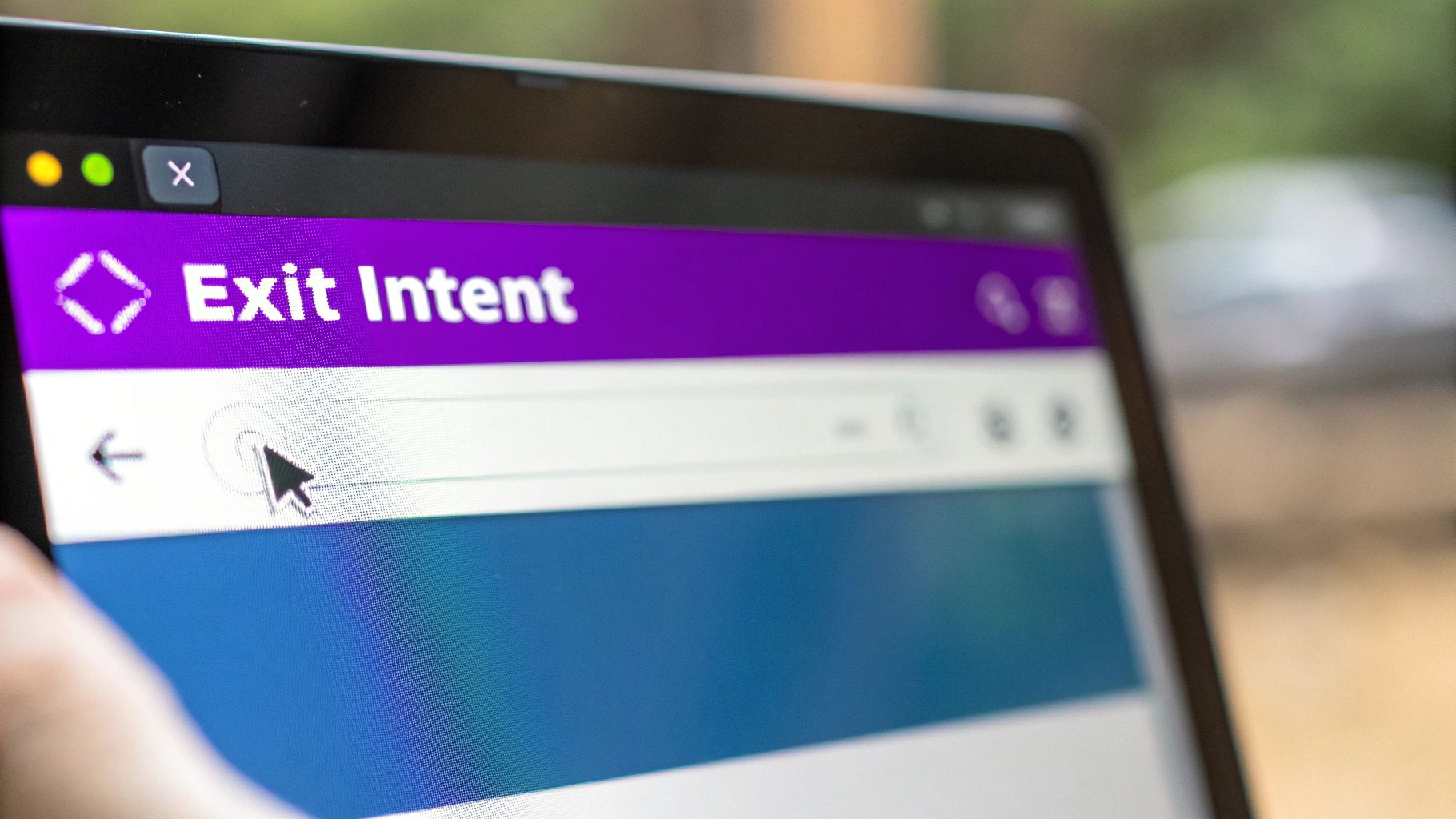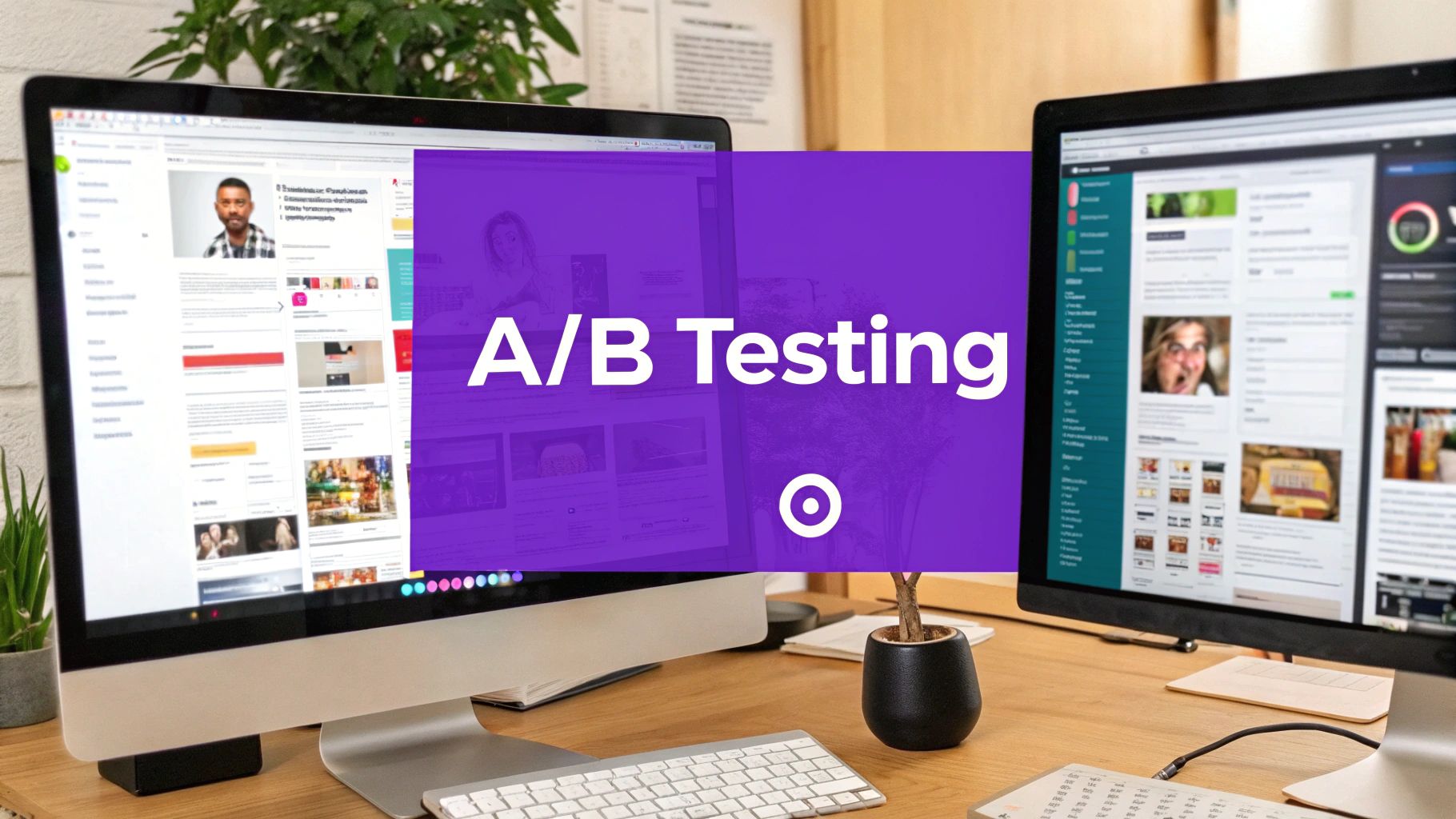Recover Abandoned Carts: Complete Strategy Guide That Works

Understanding The Real Impact Of Cart Abandonment
Let's be honest, cart abandonment is a real pain point for e-commerce businesses. It's more than just a minor annoyance; it's a serious drain on potential revenue. But the most successful online store owners don't just wring their hands in frustration; they see abandoned carts as an opportunity waiting to be unlocked. In fact, some top retailers even welcome high abandonment rates because they've figured out how to effectively bring those shoppers back.
The Cost of Lost Sales
The financial impact of cart abandonment can be substantial. Think about it: if you have 5,000 abandoned carts every month, even recovering just 20% translates to a significant number of sales you'd otherwise be missing out on. The infographic below provides a helpful visual representation of these key metrics, highlighting the potential for recovery.

While a 70% abandonment rate might seem intimidating, this data shows that recovering even a fraction of those lost sales – in this example, 20% of 5,000 carts – offers a real chance to boost profits. This underscores how critical it is to have a solid cart recovery strategy in place. The fact that the global average abandonment rate hovers around 70% reinforces just how persistent this challenge is. Statista provides further insights into these trends.
Turning Challenges Into Opportunities
Savvy businesses realize that a high abandonment rate isn't necessarily a sign of failure. Instead, it's a valuable indicator of hidden potential. By concentrating on recovering even a small portion of these abandoned carts, businesses can tap into a lucrative revenue stream.
What are some effective strategies? Targeted email campaigns, tempting discounts, and a smooth, streamlined checkout experience can all significantly improve your recovery rates. This shift in mindset – from viewing cart abandonment as a problem to seeing it as an opportunity – is a key factor in maximizing e-commerce success.
Let’s explore how abandonment rates vary across industries. The following table offers a comparison of cart abandonment rates and their impact on average order value across different e-commerce sectors.
Cart Abandonment Rates by Industry
As you can see, industries with higher average order values, like travel, are more significantly impacted by cart abandonment. Conversely, sectors with lower average order values, such as gaming, experience less of an impact. This information is important for tailoring recovery strategies to your specific industry.
Email Recovery Campaigns That Actually Convert
Forget generic "You left something behind!" emails. Let's talk about abandoned cart recovery emails that truly resonate with your customers. What's the secret sauce that transforms these emails from digital clutter into revenue generators? It's all about timing, captivating subject lines, and personalized content that addresses the reasons behind cart abandonment.
Timing Is Everything: The Recovery Sequence
Picture this: a customer abandons their cart. Sending an immediate email might feel a bit too eager. But waiting too long risks them forgetting your products altogether. The ideal timeframe for that first email is often within the first hour. A gentle nudge with a subject line like "Still thinking about it?" can work wonders. This initial email should simply remind them of the items they left behind and offer quick assistance if needed.
Follow up with a second email within 24 hours, perhaps sweetening the deal with a small incentive like free shipping. A final email after 72 hours could offer a slightly larger discount or showcase related products. This strategic sequence keeps your brand on their radar without being overwhelming.
Crafting Subject Lines That Cut Through the Noise
Your subject line is the key to recovering a lost sale. It needs to be short, engaging, and relevant to the abandoned items. Skip the generic phrases and try something more personal like, "Don't miss out on your [product name]!" Adding a sense of urgency, such as "Your cart is expiring soon," can also encourage immediate action. But avoid misleading or aggressive tactics.
For example, "Complete your purchase now!" can feel pushy, while "Your items are waiting for you" offers a softer, more welcoming approach. Testing different subject lines is essential to optimize your open rates and, ultimately, your conversions.
Personalization: More Than Just a Name
True personalization goes beyond just using the customer's name. It involves understanding why they abandoned their cart in the first place. Were they distracted? Unsure about sizing? Did shipping costs seem too high?
Your recovery emails should address these potential pain points. For instance, if a customer abandoned clothing items, include a size guide and customer reviews directly in the email. If shipping costs are a concern, highlight free shipping thresholds or offer alternative delivery options. Email campaigns focused on recovering abandoned carts are incredibly effective. Campaigns using three abandoned cart emails generate substantially more revenue—$24.9 million—compared to single-email campaigns, which yield $3.8 million. Plus, the click-to-conversion rate for automated abandoned cart messages can reach 42.02%, meaning customers who engage with these emails are highly likely to complete their purchases. Find more detailed statistics here.
Examples of High-Converting Campaigns
Leading e-commerce brands often tailor their abandoned cart emails based on customer behavior and past purchases. Imagine a loyal customer abandoning a high-value item. A personalized email offering a dedicated customer service line might be the perfect touch. For a first-time visitor, a gentle reminder with product information and social proof could be more effective.

By analyzing successful campaigns and understanding customer behavior, you can create recovery emails that feel helpful and not intrusive. This approach transforms abandoned carts from a source of frustration into a valuable revenue stream, strengthening customer relationships along the way.
Mastering Mobile Cart Recovery Strategies
Mobile commerce presents unique challenges, demanding different recovery strategies compared to desktop platforms. Leading mobile-first brands are achieving recovery rates three times higher than their competitors. Their secret? They understand the nuances of mobile shopping behavior and address the specific pain points that lead to cart abandonment on smaller screens.
Optimizing the Mobile Checkout Experience
A major factor in mobile cart abandonment is the checkout process itself. A clunky, multi-step checkout flow can quickly frustrate mobile shoppers. Consider a one-click checkout option to dramatically reduce friction, especially for returning customers.
Also, make sure your checkout forms are mobile-friendly. Minimize required fields and allow autofill wherever possible. This streamlined approach reduces form fatigue and keeps shoppers engaged.
Mobile devices present a unique challenge for e-commerce businesses. A staggering 90% of carts created on mobile devices worldwide are not checked out. This highlights the critical need to optimize mobile shopping experiences, particularly checkout simplicity and ease of navigation. High abandonment rates on mobile are often attributed to factors like complex checkout processes and high delivery fees. Learn more about shopping cart abandonment here.
Addressing Mobile-Specific Abandonment Triggers
Mobile shoppers are often on the go and subject to distractions, making them more prone to abandoning carts mid-purchase. Push notifications can gently remind them to complete their purchase.
However, these notifications must be timely and relevant. A generic "Complete your order" notification is less effective than one mentioning the specific product left in the cart. Personalization is essential.
Another critical aspect is payment friction. Offer a variety of mobile-friendly payment options like Apple Pay or Google Pay for a seamless checkout experience.
Let's take a look at how mobile and desktop recovery strategies compare:
To illustrate the varying effectiveness of recovery strategies, the following table compares conversion rates and highlights potential areas for optimization across different devices:
This table illustrates how mobile-focused recovery strategies, such as push notifications and abandoned cart SMS, can yield significantly higher conversion rates than their desktop counterparts. Focusing on streamlining the checkout process and personalizing messaging are key areas where businesses can further optimize their recovery efforts across both platforms.
Implementing a Mobile-First Recovery Strategy
A successful mobile cart recovery strategy takes a multi-pronged approach. Combining personalized push notifications with a streamlined checkout process is an excellent start. Consider progressive checkout optimization, allowing customers to save progress and return later.
Craft mobile-specific messaging for recovery emails. Focus on concise language and clear calls to action. Treat these emails as helpful nudges, not sales pitches.
Finally, ensure your website loads quickly on mobile. Slow loading times significantly contribute to cart abandonment. Optimize images and minimize unnecessary code for a smooth browsing experience. By implementing these strategies, you can significantly recover abandoned carts on mobile and convert browsers into buyers.
Advanced Automation That Feels Personal
Moving beyond basic abandoned cart email sequences is key to maximizing your recovery rate. Think of it this way: a generic "Hey, you left something behind" message rarely works. Successful stores create entire recovery strategies that respond to customer behavior, creating a personalized experience that feels genuinely helpful. This means using automation strategically to nurture potential customers without losing that personal touch.
Dynamic Content and Behavioral Triggers
Imagine sending an email that not only reminds a customer about their abandoned cart, but also offers a discount on those specific items. This is dynamic content: it adapts to the products left behind, browsing history, and even customer lifetime value. This personalized approach makes recovery emails more relevant and enticing.
For example, if a customer abandons high-value items, a personalized email offering exclusive customer support might be just the right nudge. Behavioral triggers, like browsing certain product categories or adding items to a wishlist, can also automate targeted recovery campaigns, ensuring timely and relevant communication.
Cross-Channel Messaging and AI-Driven Personalization
Today's shoppers interact with brands across many platforms. Cross-channel messaging lets you recover abandoned carts through email, SMS, push notifications, and even retargeted ads. This consistent, personalized experience increases the chance of regaining their attention and converting them into paying customers.
AI-driven personalization takes this even further by analyzing large amounts of data to predict customer behavior and tailor recovery messages. It's like having a virtual assistant predicting what each customer needs to complete their purchase. This level of personalization enhances the customer experience and improves recovery rates.
Building Intelligent Workflows
Effective abandoned cart recovery isn't about sending tons of emails. It's about building smart workflows that grow with your business. These workflows automate personalized messages based on specific triggers, keeping your recovery efforts efficient and targeted as your customer base expands. They can be as straightforward as a reminder email one hour after abandonment, followed by a text message with a small discount the following day.
Here's a sample workflow:
- Trigger: Cart abandonment
- Action 1 (1 hour later): Email reminder about abandoned items and offer assistance.
- Action 2 (24 hours later): Text message with a small discount code.
- Action 3 (72 hours later): Final email showcasing related products or a slightly larger discount.

This structured approach makes sure your recovery campaigns are not only automated, but also strategically timed and relevant to each step of the customer journey. By focusing on personalized messaging and creating an experience that feels helpful, not pushy, you can significantly improve your abandoned cart recovery rates and boost revenue growth. Remember, recovering abandoned carts is about building relationships, not just making sales.
Eliminating Abandonment At The Source
Wouldn't it be great if online shopping carts never got abandoned in the first place? While recovering them is important, the most successful online stores focus on preventing abandonment from the get-go. This means finding and smoothing out any hidden bumps in the customer journey that can stop a sale.
Auditing Your Checkout Process For Conversions
Think of your checkout process like a funnel. At each stage, some customers might slip away. A careful audit can show you where these leaks are. One major culprit? Unexpected costs. Things like high shipping fees or hidden taxes can be a real turn-off. Imagine finding a surprise shipping fee at the very end – talk about frustrating! This is a classic example of how unexpected costs can drive customers away.
A complicated or lengthy checkout process also contributes to lost sales. Too many form fields, mandatory account creation, and no guest checkout option can cause checkout fatigue. This is especially true for mobile shoppers, who often want quick and easy transactions on the go.
Building Trust and Reducing Friction
Trust is everything in online shopping. Displaying security badges, like a "Secure Checkout" badge, offering secure payment options through providers like Stripe, and providing clear contact information reassures customers. It's like a virtual handshake, letting them know their information is safe with you.
Offering various payment options is also crucial. Not everyone uses PayPal or credit cards. Alternatives like Apple Pay or Google Pay can greatly reduce payment friction. This makes checkout smoother and caters to a wider range of customers. Small changes like these can make all the difference.
Simple Changes, Big Impact: Case Studies
Many stores have seen huge drops in their abandonment rates with just a few targeted tweaks. One store simplified its checkout process by reducing form fields and saw a 15% decrease in cart abandonment. Another added live chat for immediate customer support, leading to a 10% improvement in conversions.
These examples show the importance of fixing those friction points. Sometimes, the smallest changes have the biggest results. By actively removing abandonment triggers, you're not just saving lost sales. You're building a better, more customer-focused shopping experience that encourages loyalty and long-term growth. It's about a smooth and enjoyable experience from beginning to end.
Measuring And Optimizing Recovery Performance
Turning your abandoned cart recovery efforts from a guessing game into a data-driven strategy is key for maximizing revenue. This means focusing on the right key performance indicators (KPIs) and understanding the metrics that truly matter. Successful e-commerce stores don't just send recovery emails; they carefully track their performance and constantly optimize.
Key Metrics for Recovery Success
Instead of getting lost in less important metrics like email open rates, focus on those directly impacting your bottom line. These include:
Recovery Rate: This is the percentage of abandoned carts that turn into sales. A higher recovery rate means a successful strategy. For example, a 20% recovery rate means you're recovering one in five abandoned carts.
Revenue Recovered: This measures the actual dollar amount generated from recovered carts. Tracking this helps you understand the financial impact of your recovery efforts. Recovering $156,915 in 30 days shows a strong return on investment.
Conversion Rate: This is the percentage of customers who click your recovery email and make a purchase. A high conversion rate indicates compelling email content and effective calls to action. A 58% conversion rate from a recovery email means almost two out of three people clicking are buying.
Setting Up Effective Tracking Systems
To accurately measure these KPIs, you need a reliable tracking system. Most e-commerce platforms like Shopify offer built-in analytics dashboards that provide data on cart abandonment and recovery rates. Also, connecting your email marketing platform, such as Mailchimp, with your e-commerce platform allows for precise tracking of email campaign performance. This data helps you pinpoint areas for improvement and refine your recovery strategies. You can track which email subject lines get the most opens and which discounts best encourage conversions.

A/B Testing for Recovery Campaigns
A/B testing is crucial for optimizing recovery emails. This means testing different versions of your emails to see which works best. Experiment with different subject lines, email copy, discount offers, and call-to-action buttons. By analyzing the results, you can figure out what resonates with your audience and drives conversions.
When A/B testing, focus on statistical significance. This ensures your results aren't just random. Aim for a 95% confidence level, meaning there's a high probability the performance differences you see are real.
Practical Dashboards and Reporting
Finally, use dashboards and reports to visualize your recovery performance data. This can be a simple spreadsheet tracking your KPIs or a more complex dashboard within your e-commerce platform. Regularly checking your recovery rate, revenue recovered, and conversion rates helps you spot trends, adapt your strategies, and ensure long-term success. These insights will help you constantly refine your recovery campaigns, maximizing their impact and driving consistent revenue growth. A well-optimized abandoned cart recovery strategy can be a major growth driver for your e-commerce business.
Key Takeaways
Building a robust system for recovering abandoned carts is essential for any e-commerce business. This isn't a one-size-fits-all approach; it requires a dynamic strategy that adapts to your specific customers and their evolving behaviors. Let's explore the essential elements of a successful abandoned cart recovery strategy.
Understanding Why Carts Are Abandoned
Before diving into solutions, it’s important to understand why customers abandon their carts. Common reasons include:
Unexpected Costs: High shipping fees or taxes revealed late in checkout can be major deterrents. No one likes surprises at the last minute!
Complex Checkout: A long or confusing checkout process, especially on mobile, can frustrate customers. Too many form fields or forced account creation can lead to checkout fatigue.
Website Performance: Slow loading times can make customers impatient. In e-commerce, every second counts.
Lack of Trust: Customers need to feel secure sharing payment information. Missing security badges can erode trust.
Identifying these pain points in your checkout flow is the first step to implementing effective solutions.
Implementing Effective Recovery Tactics
Once you understand the reasons behind cart abandonment, you can start implementing proven recovery tactics. Consider these options:
Targeted Email Campaigns: Instead of generic emails, craft personalized messages triggered by cart abandonment. The first email, sent within an hour, should remind the customer of their items. Later emails can offer incentives like free shipping or discounts.
Mobile Optimization: Mobile shoppers abandon carts more often than desktop users – a staggering 90% globally. Streamline your mobile checkout and offer mobile payment options. Push notifications can also serve as gentle reminders.
Personalization and Automation: Dynamic content in recovery emails, like showing the abandoned items, can improve conversions. Automated workflows can trigger emails based on customer behavior, such as browsing history.
These strategies are most effective when combined. For example, a customer abandons a cart on their phone and receives a push notification, followed by a personalized email. This multi-pronged approach maximizes your recovery chances.
Measuring and Optimizing for Continuous Improvement
Recovering abandoned carts requires constant monitoring and optimization. Track key metrics like recovery rate, revenue recovered, and conversion rate. A/B testing can help you experiment with different email subject lines and offers. Analyzing these metrics helps you understand what's working and where you can improve. For example, a low open rate suggests trying different subject lines. A low conversion rate might mean a different incentive is needed.
Eliminating Abandonment at the Source
Preventing abandonment is even better than recovering lost sales. Address the root causes by optimizing your checkout process, offering multiple payment options, clearly displaying security badges, and being upfront about all costs. This creates a better shopping experience for all customers, leading to higher conversions overall.
Building a System That Grows With You
As your business grows, your recovery strategy needs to scale. This means automating workflows, segmenting customers for targeted campaigns, and using data-driven insights. The right tools and platforms, such as automated text message campaigns, can help manage this complexity. One client recovered $156,915 in 30 days using such campaigns. Another recovered nearly two out of three lost sales through well-crafted text messages and timed follow-ups. These results highlight the power of a well-executed recovery strategy.
Building a successful e-commerce business requires understanding your customers and optimizing every step of their journey. Recovering abandoned carts is a crucial piece of this puzzle. By implementing these key takeaways, you can turn lost sales into recovered revenue and build lasting customer relationships.
Ready to transform your e-commerce business? Wand Websites can help. We specialize in building high-performing Shopify stores designed to convert visitors into loyal customers. Learn more about how Wand Websites can help you grow your business.


